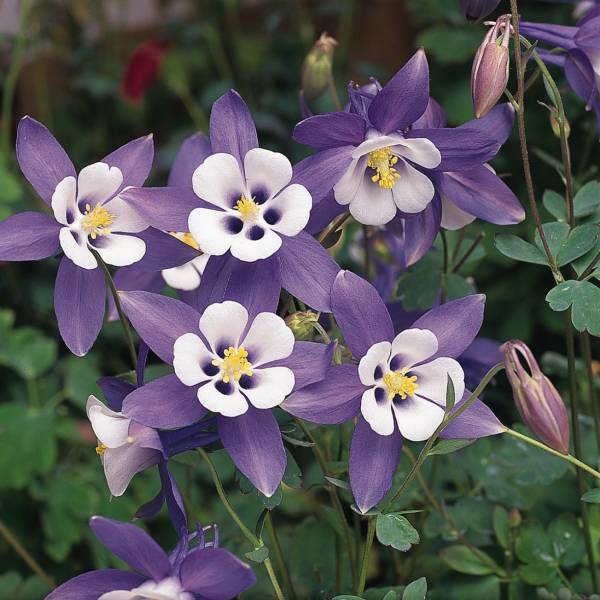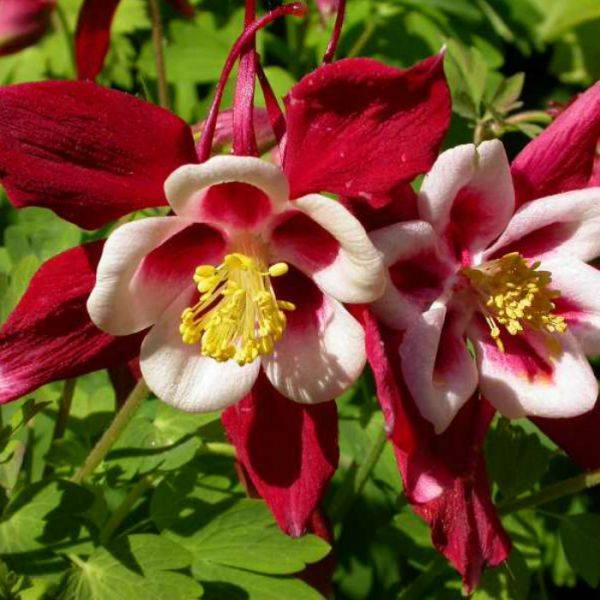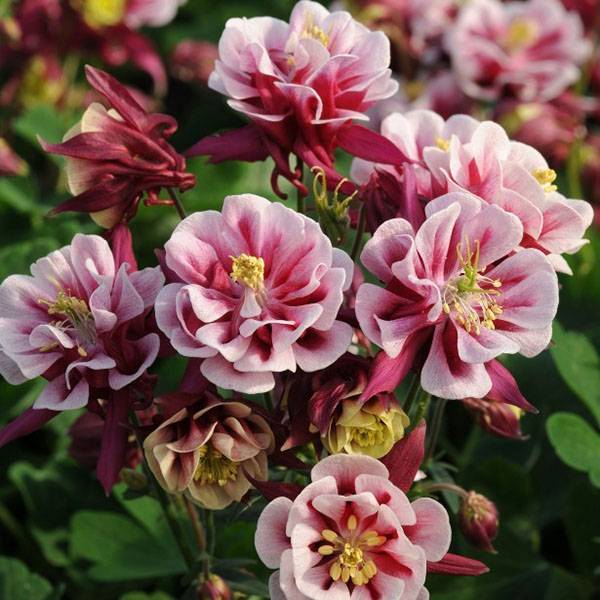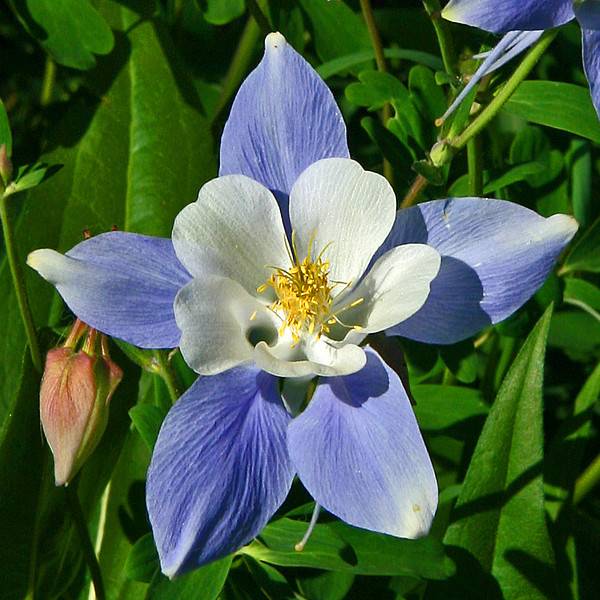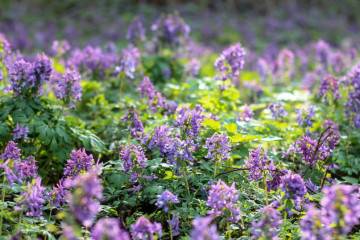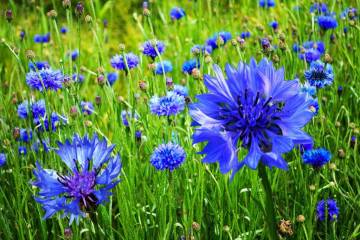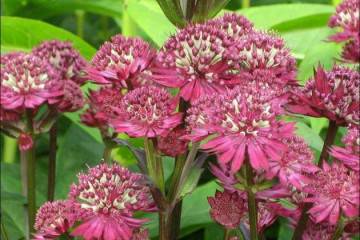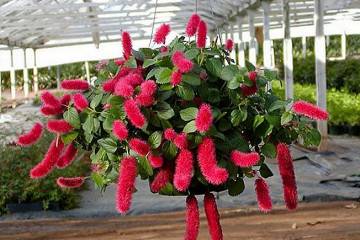Aquilegia flower
Content:
Herbaceous perennial shrubs of the Buttercup family include aquilegia, known by other names as the catchment, orlik. Botanists have identified 120 varieties of a flower, of which about 35 subspecies are grown on personal plots.
Aquilegia - flower catchment, or perennial catchment
Aquilegia is a compact shrub with shoots, firm and strong peduncles. Bicolor flowers are available in a wide range of colors. Planting and caring for aquilegia in the open field is not difficult for beginners, since the bushes need timely mineral feeding and watering.
The aerial part of the bush can reach 1 m, the roots have a pivotal form and a large number of branches located at a depth of up to 0.5 m. Every year, renewal buds form at the base of the shoots, later they form rosettes from which foliage and flower stalks grow.
Flowering period
An early summer plant is characterized by:
- long peduncles: from 0.6 to 1 m;
- large flowers: from 6 to 10 cm;
- a variety of colors of petals: can be golden, orange, purple, snow-white, bluish, cornflower blue, pinkish;
- corolla with 5 petals, thin spurs: 5 to 7 cm.
How long does aquilegia bloom
The duration of bud retention depends on the variety. Some varieties adorn plots for one month, in May or June, others - until the first frost. For aquilegia, care after flowering consists in pruning the stems to the root outlet. Then the ripening time of fruits begins - many-leaves, in which small black seeds ripen. Germination is maintained throughout the year, self-seeding is possible.
Aquilegia varieties
There are many varieties of aquilegia. Growers prefer varieties that are suitable for local conditions. It could be Nora Barlow, Clementine, or whatever.
The bushes are chosen according to the description, for example, it is useless to sow some varieties in Siberian conditions. Young seedlings from the set for the central part of Russia will die before they release the first flower stalk.
Terry aquilegia
It blooms after disembarkation in the second year. In the first summer, a basal rosette forms, from which new leaf plates and flower stalks develop annually. The difference between terry aquilegia is considered to be long spurs and buds, collected in inflorescences that resemble panicles.
The size of double flowers does not exceed 8 cm.The color is quite varied:
- dairy;
- blue;
- several shades of pink;
- purple.
The foliage is arranged on long cuttings. After cutting, the flowers do not fade for a long time, for 2 weeks, which allows them to be used in various bouquet arrangements.
Terry aquilegia prefers to grow in shaded areas, in natural conditions it grows:
- in the forest, in the meadows;
- in the Central zone of the Russian Federation on mountain slopes;
- in Altai, in the Tien Shan mountains;
- in the Crimea, the Caucasus, the hills of the Far East.
Some subspecies are found in European countries, the USA.Recently, shrubs have begun to be used to decorate household plots and city flower beds. For this purpose, hybrid crops are suitable that look prettier and brighter than their wild fellow tribesmen.
In the middle zone, several varieties of aquilegia are common. Barlow includes a series of subspecies with pink and burgundy petals. The center of the corolla is colored darker. Compared to other varieties, the variety has a large number of petals.
- Barlow Black is short flowering from June to July. It grows up to 60 cm, flower petals are indigo or almost black.
- Barlow Pink up to 80 cm high with bright scarlet flowers. Decorates the front garden for about 2 months, prefers moist soil and shady areas.
- The Christa variety has larger lilac flowers than other varieties.
Aquilegia hybrid
The herbaceous perennial has erect, branched stems, reaching from 0.5 to 1 m in height. The foliage is openwork, on the surface there is a bluish bloom, collected in a basal rosette. There are subspecies with a variegated color of leaf plates. The root shaft is large with a thickening near the base.
Flowers of large size, double or simple type, variants with long spurs are more common. They come in different colors: from white and yellow-gold to pink and lilac.
Corollas and spurs often have different contrasting colors. The buds are collected in panicle-like inflorescences, which are located on long peduncles. The hybrid aquilegia blooms with the beginning of summer, decorating the front gardens for almost the entire season.
Popular hybrids include:
- Biedermeier - the selection is based on a common wild-growing variety. It is distinguished by increased resistance to adverse weather conditions, does not require special care when growing. An adult bush grows no more than 50 cm, buds of various tones are located on strong and long peduncles. The flowers are often two-colored with a combination of purple and yellow, snow-white and cornflower blue, lilac and turquoise;
- MacKana has terry flowers of heavenly, yellow, purple, scarlet, cherry shades. A distinctive feature of the subspecies is the absence of drooping buds in the middle of the day. The maximum size of the bush reaches 1.3 m;
- The star is characterized by huge flowers of blue, pink, blue, red, milky shades with a light center. The average height is from 60 to 80 cm, the foliage is openwork in a gray tone. The variety is not afraid of the cold, prefers to grow in the shade on moderately moist soil types. In one place it can grow from 3 to 5 years;
- The tower is distinguished by double flowers, collected in large inflorescences up to 5 cm in diameter. Tall, up to 80 cm, the bush is decorated with gray-green leaves. The root system is pivotal, so the variety easily tolerates winter outdoors. It blooms from May to July with a pale azure color;
- The cameo is a dwarf fan-shaped variation not exceeding 15 cm in height. The multi-colored buds bloom early, they are up to 3 cm in diameter. The common color of the petals is snow-white, blue, milky, crimson, snowy, pink and whitish.
Aquilegia ordinary
The subspecies is distributed in Scandinavia, Southern and Central Europe. It prefers to grow in forest, meadow, mountainous areas at an altitude of about 2 thousand meters above sea level.
The catchment is represented by a sprawling bush 80 cm high. Flowers of a lilac shade in diameter up to 5 cm. Spurs are small in size, they are bent. The leaves are of a bluish tone, cut into three parts in two places. The variety has a taproot with a thickening in the upper section.
Aquilegia vulgaris prefers to grow on loamy soils and in sandy soils with low acidity. The buds appear in late May and early June. It reproduces by self-seeding. Easily tolerates severe cold, does not require a special winter shelter. Bushes are planted in partial shade.
Aquilegia Winky
It can be grown not only outdoors, but also as a pot culture. The bush is compact, durable, with a height of 35 to 50 cm.The flowers have a variety of shades:
- white;
- yellow;
- burgundy;
- pink;
- purple;
- lilac.
There are two-tone specimens combining lilac and beige, milky and turquoise. Flowers consist of five petals, spurs are located on them. Inflorescences rise above the bushes on long peduncles. A feature of the subspecies is the directionality of the flowers: unlike the rest, they do not droop, but look up. Winky's aquilegia bloom is abundant and long-lasting.
Aquilegia yellow
Recognized since 1873, characterized by a height of up to 1 m, straight and branched shoots, light green foliage. There are also undersized, up to 40 cm, varieties. Flower up to 4.5 cm in diameter with a pale yellow sepal, dark yellow petals, spurs up to 4 cm in length. Blooms from early June.
Gardeners often prefer the yellow Queen aquilegia - a graceful flower up to 1 m high with openwork gray-green foliage and large yellow-golden buds. They are decorated with long spurs, collected in loose paniculate inflorescences. The bush is decorated with buds for a long time, they appear in large quantities. In one place it grows up to 5 years, prefers shaded household plots with moderate moisture.
Aquilegia Columbina
Long-lived compact shrubs about 70 cm high. Colombian aquilegia feels better in shade and is cold-resistant. The buds are up to 6 cm in diameter, they bloom from the end of May, bloom all June. The paniculate inflorescences of the Columbine aquilegia rise above the main bush. The variety is used in group plantings together with annuals to decorate recreation sites.
For aquilegia, proper cultivation and care plays an important role, since when located in bright sunlight, it loses its color, often gets sick and may die.
Aquilegia white
White aquilegia has several hybrid and simple forms. It is distinguished by a pure snow-white color of the buds, which does not have foreign inclusions. Common varieties:
- Belaya Zvezda - neat aquilegia with bluish foliage, varietal flowers. The bushes are beautifully shaped up to 70 cm high. Large buds appear in May, flowering lasts until July. The bush is not afraid of cold weather, grows better in the shade, requires a moist and fertilized soil;
- White Barlow grows up to 60-70 cm, in width reaches 30-60 cm. It belongs to the subgroup ordinary, can withstand frosts from 31 ° C to 34 ° C. Snow-white buds bloom in May, last until the end of June. Bushes prefer partial shade;
- Jewel White is ideal for growing in flower gardens. In May, the variety pleases with exuberant flowering, which ends in early July. Bushes up to 30 cm in height, flowers are large, they are collected in several pieces on one peduncle. Jewel White under suitable weather conditions can bloom again in August.
Alpine aquilegia
The ancestral home of this species is the Alps.It grows at an altitude of up to 2.5 thousand meters above sea level in the forest, mountains, on rocks. In the natural environment, the height of the bushes does not exceed 40 cm; larger specimens are also found on the personal plot.
Alpine aquilegia blooms in June, buds up to 8 cm in diameter in a large size of a heavenly or lilac shade. One stem has 2 to 3 flowers. The foliage is twice divided into trifoliate subsections with a deep section, it is painted in a gray-green tone. In basal leaves, stem petioles are seated subspecies. The main root is large tap root.
Perennial preference is given to light sandy soils, it can grow on loamy soil types. The acidity should not exceed 7.5 pH. The bushes are drought tolerant, but the need for watering should not be ignored, especially in the heat.
This variety is cold-resistant, able to survive after frost up to 28 ° C, but subject to preliminary wrapping. Distributed in Siberia and the Urals. Foliage, spruce branches or compost are used as material for additional heating.
Aquilegia grows in one place for up to 5 years, releasing new shoots every year. Young bushes that have appeared in place of old ones are distinguished by small and faded flowers, poor development. In their place, you need to plant new seedlings.
Aquilegia, planting and caring for which will not be difficult, with proper supervision, will decorate the site for several years in a row. It fits perfectly into various landscape projects, complements the already composed compositions. Experience for growing bushes is not needed, since an unpretentious flower does not require special knowledge and skills, it is suitable for novice amateur gardeners.
Video


